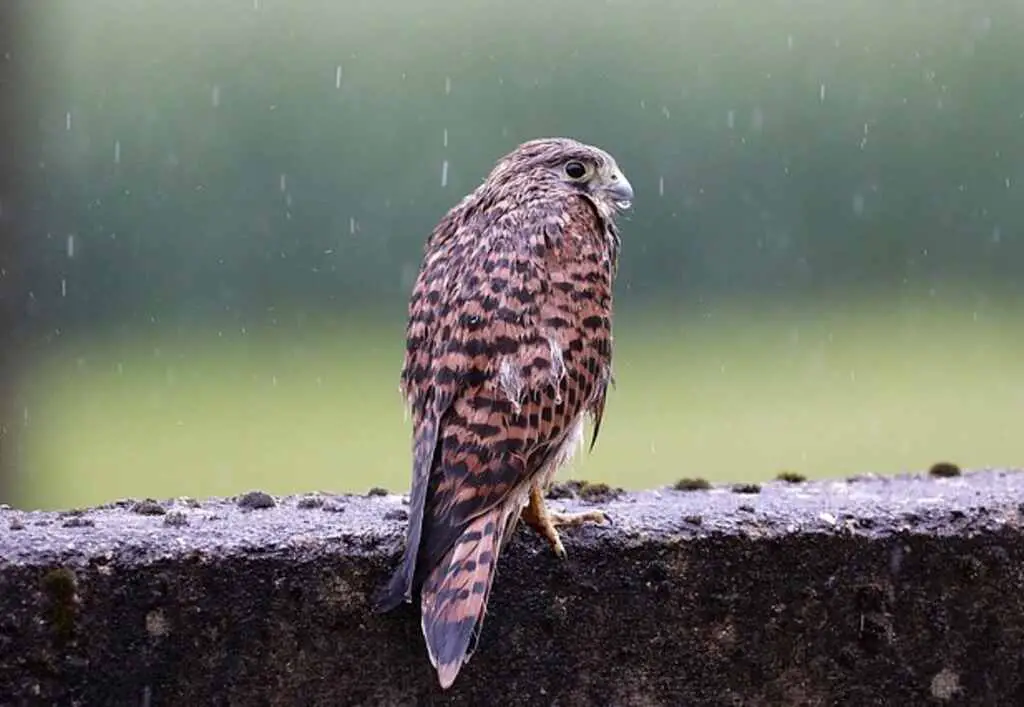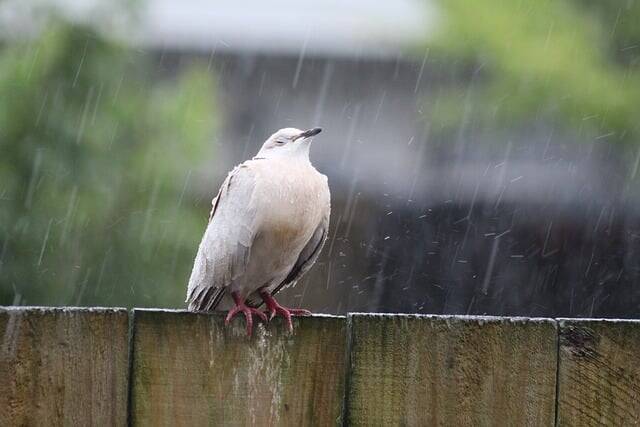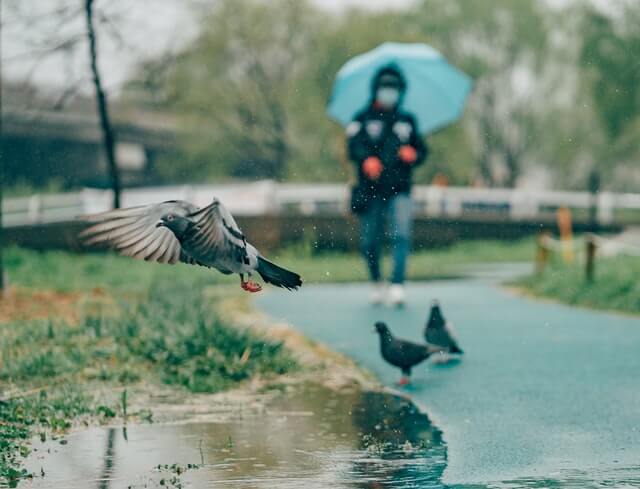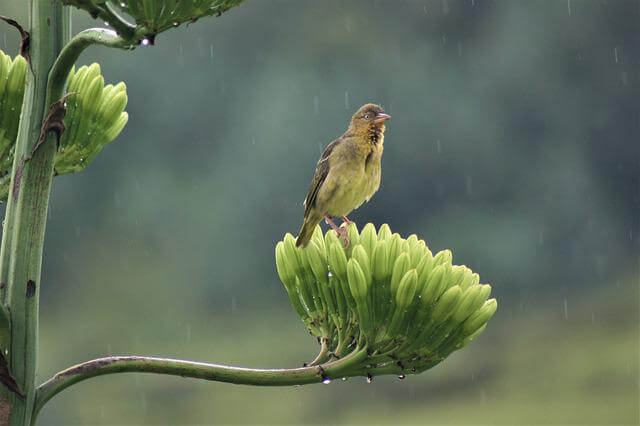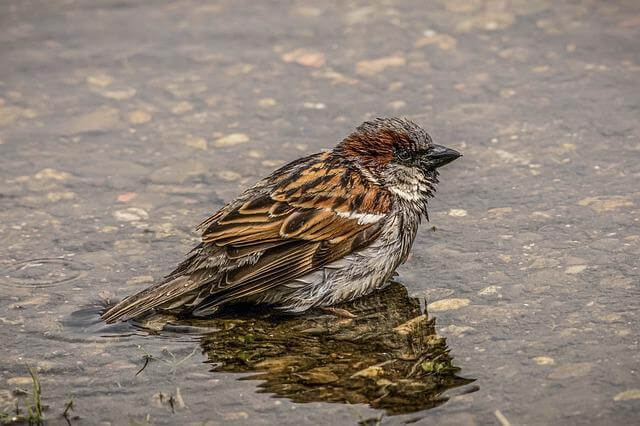Rainy days have a unique charm, with the soothing sound of water droplets falling from the sky. But as we watch the rain, it raises an intriguing question: Can Birds Fly in Rainy Weather?
In this investigation, we’ll dive into the world of avian flight and uncover the secrets behind birds taking to the skies, even when raindrops are falling. Join us on this journey as we explore whether the rain can truly dampen a bird’s wings.
Table of Contents
- 1 Key Takeaways:
- 2 Can birds fly in the rain?
- 3 What do birds do when it rains?
- 4 How long can birds fly in the rain?
- 5 Can all birds fly in the rain?
- 6 Can birds fly in heavy rain?
- 7 Is it harder for birds to fly in the rain?
- 8 Why do birds not fly in the rain?
- 9 Why do birds fly in the rain?
- 10 Can birds fly with wet wings?
- 11 Can birds fly when wet?
- 12 Can birds fly in the wind?
- 13 Can birds fly in the snow?
- 14 Can hummingbirds fly in the rain?
- 15 Can ravens fly in the rain?
- 16 Can pigeons fly with wet wings?
- 17 Can birds fly with wet feathers?
- 18 Why can’t birds fly with wet wings?
- 19 Can eagles fly with wet wings?
- 20 Do birds like to get wet?
- 21 Can birds fly in the dark?
- 22 Can birds fly in space?
- 23 Can birds fly backwards?
- 24 Conclusion
- 25 Author
Key Takeaways:
- Many birds can fly in light rain due to their waterproof feathers.
- Heavy rain can hinder flight by making feathers waterlogged.
- Birds may seek shelter or rest during heavy rain.
- Some bird species are adapted for rainforest or wetland environments.
Can birds fly in the rain?
Yes, birds can fly in the rain, but they don’t do it very well. In fact, most birds will try to avoid flying in the rain if at all possible. The main reason why birds don’t fly well in the rain is because the rain makes their wings wet and heavy.
This extra weight makes it more difficult for them to fly, and it also causes them to lose altitude more quickly.
Additionally, the rain can obscure a bird’s vision and make it harder for them to navigate. Despite these challenges, however, some birds are able to fly in the rain.
What do birds do when it rains?
When it rains, birds often find shelter. Some birds, like the American Robin, will find a spot under a tree or other cover. Other birds will go to birdhouses or other places where they can be protected from the rain. Some birds, like the American Goldfinch, will eat while it is raining. The American Goldfinch eats seeds that have been softened by the rain.
How long can birds fly in the rain?
Birds can fly in the rain for a while, but eventually they will need to find shelter. The amount of time they can fly in the rain depends on the type of bird and how hard it’s raining.
Small birds, like sparrows, can usually fly for about half an hour in light rain. Larger birds, like eagles, can usually fly for an hour or two in light rain. If it’s raining really hard, all birds will need to find shelter soon.
Can all birds fly in the rain?
No, not all birds can fly in the rain. In fact, many bird species will avoid flying in the rain altogether. Birds that are likely to fly in the rain are typically large birds with strong wingspans, like eagles or vultures. Smaller birds, like hummingbirds or finches, are more likely to take cover during a storm.
This is because smaller birds have less muscle mass and aren’t as well-equipped to handle the added weight of wet feathers. Additionally, wet feathers can make it difficult for a bird to stay airborne and can lead to hypothermia if the bird is flying in cold weather.
Can birds fly in heavy rain?
Most birds are quite capable of flying in light to moderate rain. However, if it’s pouring down hard or there’s a lot of wind, most birds will stay on the ground.
This is because flying in heavy rain can be quite challenging due to the weather conditions and can tire out a bird quickly.
Is it harder for birds to fly in the rain?
Flying in the rain can be difficult for birds. When it rains, the air pressure drops and the air is less dense. This makes it harder for birds to fly because they need to use more energy to lift their bodies against the resistance of the air.
Additionally, when rain falls on a bird’s feathers, it creates drag and makes it more difficult for the bird to move through the air.
Why do birds not fly in the rain?
There are a variety of reasons why birds do not fly in the rain. One reason is that the rain can make it difficult for birds to see.
Additionally, the rain can weigh down birds’ wings, making it difficult for them to fly. Wet feathers can also make it hard for birds to stay in the air.
Finally, many birds rely on visual cues from other birds to navigate, and at night or in bad weather conditions these cues are not available.
Why do birds fly in the rain?
There are a few reasons why birds fly in the rain. One reason is that they need to find food. When it rains, the ground is wet and there are more insects and worms to eat.
Birds also like to fly in the rain because it’s a good way to clean themselves. The rain washes away dirt and bugs from their feathers. Finally, some birds fly in the rain because they enjoy it!
Can birds fly with wet wings?
When a bird’s wings are wet, they become heavier and less aerodynamic. This makes it harder for the bird to generate lift and stay in the air. In fact, a bird with wet wings can lose up to 50% of its flying ability.
Despite these challenges, birds can still fly with wet wings. They may not be able to travel as far or as fast as they would normally, but they can still get where they need to go.
Can birds fly when wet?
Birds can fly when wet because they have a waterproof outer layer that helps protect them from the rain. This layer is made up of feathers that have an oil from the preen gland.
The preen gland is located near the tail, and it produces a sticky substance that coats the feathers. This oil helps keep the feathers in place and makes them water-resistant.
Birds can still fly when they’re wet, but they may not be as efficient at it. The extra weight of the water can make them slower and less agile.
Can birds fly in the wind?
Yes, birds can fly in the wind. Birds have evolved to be able to fly in a variety of conditions, including windy ones. Their wings are specially adapted to help them stay in the air and maneuver through the air currents. In fact, many birds use the wind to their advantage, flying along with it or using it to help them gain altitude.
So next time you’re out watching birds and notice how they seem to be effortlessly flying around despite the wind, you’ll know that they’re just taking advantage of what nature has given them!
Can birds fly in the snow?
Birds have feathers that help them stay warm and keep them flying in cold weather. Their feathers trap air close to their skin, which helps keep them warm.
Birds also have a high metabolism, which means they generate a lot of heat. This helps them stay warm in cold weather.
Birds can fly in light snow, but they might not be able to fly in heavy snow. The snow might weigh down their wings and make it difficult for them to fly.
Can hummingbirds fly in the rain?
Hummingbirds are able to fly in the rain because their wings are specially adapted to be efficient in wet weather. Their wings have a unique shape that allows them to cut through the air more easily, and they also have a higher wing loading than most other birds, which means they can fly faster and stay in the air longer. In addition, hummingbirds’ feathers are covered with a water-repellent coating that helps keep them dry.
Can ravens fly in the rain?
Ravens can fly in the rain, but it is more difficult for them to do so. Their feathers become wet and heavy in the rain, which makes it harder for them to stay in the air.
However, ravens are very resourceful birds, and they will usually find a way to get where they need to go despite the adverse weather conditions.
Can pigeons fly with wet wings?
Pigeons can fly with wet wings, but they will not be able to fly as far or as fast as when their wings are dry. In fact, during light rain, pigeons will often fly a short distance to take cover. When it rains harder, they will stay on the ground.
Can birds fly with wet feathers?
Birds can fly with wet feathers, but there are a few things to consider.
Dry feathers provide more lift and are more efficient in flight than wet feathers. So, if a bird needs to fly while its feathers are wet, it will have to work harder and use more energy.
Birds have special oils in their feathers that help them repel water. However, these oils can only do so much; if a bird’s feathers get too wet, they will no longer be able to repel water and will become heavy.
In order to fly with wet feathers, a bird must flap its wings more quickly and work harder to stay in the air. It may also need to land sooner than usual so that it can dry off.
Why can’t birds fly with wet wings?
Birds can’t fly with wet wings for a few reasons. The most important reason is that wet feathers don’t create enough lift to keep the bird in the air.
The air passing over a wet feather is slowed down by the water on the surface of the feather, and this decrease in speed creates less lift.
In addition, when feathers get wet, they become less buoyant and can’t support the bird’s weight. Finally, when birds fly with wet wings, they lose energy more quickly because their wings are not as efficient as they are when they’re dry.
Can eagles fly with wet wings?
Yes, eagles can fly with wet wings. Their feathers are coated in a waterproofing oil that helps keep their wings dry while they are flying.
In addition, the air passing over their wings creates a natural wind tunnel that helps keep the feathers dry. If an eagle’s wings do get wet, they will lose some of their lift and stability, but they will still be able to fly.
Do birds like to get wet?
Birds like to get wet. In fact, they need to get wet in order to keep their feathers clean and healthy. Birds will take baths in ponds, lakes, and even puddles if they have to. They will also use water to clean their feathers by shaking their heads and flapping their wings.
Can birds fly in the dark?
Birds can fly in the dark if they need to, but it is not a common occurrence. Most birds prefer to fly during the day, when there is more light available. However, if they are disturbed or during migration, they will often fly in the dark.
Birds use their vision and other senses to navigate in the dark. They can see well enough to avoid obstacles and find food. Some birds, such as owls, have specially adapted eyes that allow them to see well in the dark.
Can birds fly in space?
In space, there is no air. This means that there is no oxygen for birds to breathe. Without oxygen, birds cannot fly. Additionally, the low pressure in space would cause a bird’s body to expand and rupture. Therefore, birds cannot fly in space.
Can birds fly backwards?
Hummingbirds are the only birds that can truly fly backwards. They can do this because they have a special maneuvering technique called “hovering”.
By flying forwards and then stopping abruptly, they create a vacuum behind them that sucks them back up into the air. This allows them to change direction quickly and easily, which comes in handy when they’re chasing insects or dodging predators.
Conclusion
While many birds can fly in light rain thanks to their waterproof feathers, heavy rain can pose challenges. Waterlogged feathers can hinder flight, and birds may seek shelter or rest during adverse weather. Understanding a bird’s environment and adaptations helps explain their ability to fly in the rain.

